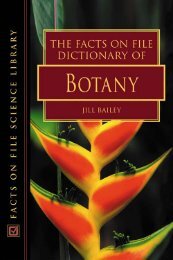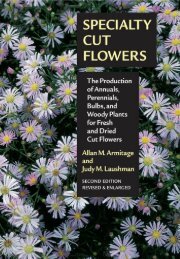You also want an ePaper? Increase the reach of your titles
YUMPU automatically turns print PDFs into web optimized ePapers that Google loves.
tlme (3.17). The primary phloem and the early<br />
secondary phloem (3.27, 6.23) frequently become<br />
crushed between the pericyclic or corrical sclerenchyma<br />
and the expanding xylem cylinder, and<br />
even in older stems the secondary phloem remains<br />
a relatively narrow layer (3.44). However, if axial<br />
fibres develop abundantly in the secondary<br />
phloem the older tissue may remain discrete<br />
(3.37). To accommod:ne the increasing circumference<br />
of the Stem, the ilHervening ray parenchyma<br />
cells divide periclinally so that the rays<br />
flare outwards (3.37).<br />
In a number of secondary thickened dicotyledonous<br />
stems, especially in climbing plants<br />
(Iianes), the pattern of vascular development is<br />
anomalous. In the tropical liane Ballhinia the<br />
older stem (6.24) is irregular and often ribbon-like<br />
and somewhat flexible. In early secondary growth<br />
the cambium produces uniform xylem. However,<br />
the cambium soon becomes more active on<br />
opposing sectors of the stem and produces thick<br />
wedges of largc-Iumened vessels (6.25), while the<br />
intervening areas of xylem arc thin and have<br />
narrow tracheary elements. The form of the<br />
mature liane becomes more complicated as further<br />
vascular tissues differentiate from the dilated rays<br />
running across the fissured xylem (6.24). In<br />
Tinospora the tays are greatly inflated so that the<br />
secondary xylem is separated into tapering wedges<br />
(6.26). In other stems new vascular cambia may<br />
arise successively further from the centre of the<br />
stem producing concentric rings of xylem and<br />
phloem, or the cambium sometimes produces<br />
phloem centripetally.<br />
Periderm<br />
In gymnosperms and woody dicotyledons the<br />
epidermis of the stem is normally replaced by the<br />
protective cork and associated tissues (3.13, 3.17,<br />
3.41,3.44,6.27,6.28). The outermoSt region of<br />
this periderm comprises the phellem (cork, 1.30)<br />
derived from the phellogen (cork cambium). This<br />
is a meristematic layer of tangentially flattened<br />
cells which commonly arises hypodermally (5.8).<br />
It may also be of epidermal origin (6.29) or may<br />
form deeper in the cortex. In some species the<br />
cork cambium cuts off a little parenchymawus<br />
tissue (phelloderm) internally. The cork consists of<br />
radially aligned, tightly packed cells; they are dead<br />
and have thickened walls which are suberiscd and<br />
impermeable. Periderm also forms over wounded<br />
surfaces (5.48, 5.49, 6.30) and occurs in thickened<br />
stems of some monocotyledons (6.31).<br />
Commercial cork is harvested from Quercus<br />
Silber (3.13) and is stripped off the trees in cyeles<br />
of about 10 years (6.28). In this species each<br />
phellogen produces several millimetres of cork and<br />
is then replaced by new phellogens which arise in<br />
successively deeper regions of the cortex and<br />
eventually in the outer second:lrY phloem (3.41).<br />
The removal of the cork crop does not harm the<br />
vascular cambium of the oak tree. In most woody<br />
species the outer dead bark (rhytidome) is<br />
periodically sloughed off the trunk and main<br />
branches. The rhytidome consists of successively<br />
deeper-formed, discontinuous but overlapping<br />
periderms and intervening patches of nonfunctional<br />
phloem (3.41).<br />
The cork is impermeable to gaseous diffusion<br />
but the numerous lenticels (4.22, 6.32, 6.33)<br />
facilitate the movement of oxygen into the living<br />
tissues within this barrier and also allow the exit<br />
of carbon dioxide. Lenticels arise from less tightly·<br />
packed regions of the phellogen, and the cork<br />
(complementary tissue) produced consists of<br />
rounded cells with large intracellular spaces<br />
between them. In maoy woody species layers of<br />
more compact cork are produced periodically and<br />
these retain the loose complementary cells within<br />
the lentice!.<br />
Thickened monocoryledonous stem<br />
The majority of monocotyledons are herbaceous,<br />
bur in bamboos and some other species the stem is<br />
relatively wide (6.34) due to the activity of the<br />
primary thickening meristem. In this meristem the<br />
cells are aligned in a transverse or oblique sheet<br />
and undergo peric1inal divisions (6.15), with the<br />
internal derivatives differentiating into the axial<br />
vascular bundles and ground parenchyma (4.15).<br />
During carly growth of most ptllms the internodes<br />
remain short, while diffuse growth and division<br />
within thc ground parcnchyma leads to the stem<br />
becoming progressively thicker. When the stem<br />
reaches its adult diameter (5.50), internodal<br />
elongarion occurs and some species may attain<br />
great heights and life span.<br />
In the very few truly wooch monocotyledonous<br />
genera (e.g. Dracaella, Yucca, Cord)'lille)<br />
anomalous secondary growth occurs hecause of<br />
the activity of the secondary thickening meristem<br />
(1.22,5.2,6.35). This forms in the outer cortex of<br />
the older stem (6.36) and often links with the<br />
primary thickening meristem of rhe younger<br />
shoot. The secondary thickening merisrem cuts off<br />
complere vascular bundles centripetally which are<br />
119





